Histological and Transcriptomic Insights into Rugose Surface Formation in Pepper (Capsicum annuum L.) Fruit
Abstract
1. Introduction
2. Results
2.1. Validation of the CAD-Based Rugosity Quantification Method
2.2. Association Between Fruit Surface Rugosity and Texture-Related Indicators
2.3. Morphological and Cellular Analyses
2.4. Transcriptome Analyses and Validation of Developmental Stages in Rugose Fruits
2.5. Expression Profiling of Candidate Genes Across Different Tissues and Developmental Stages
3. Discussion
4. Materials and Methods
4.1. Plant Materials and Phenotype Observation
4.2. Development of Method for Phenotype Measurement of the F2 Population
4.3. Measurement of Biochemical Indicators Related to Texture Quality
4.4. Paraffin Section and Scanning Electron Microscopy
4.5. RNA-Seq Analysis
4.6. Expression Analysis Using qRT-PCR
4.7. Statistical Analysis
5. Conclusions
Supplementary Materials
Author Contributions
Funding
Data Availability Statement
Conflicts of Interest
Abbreviations
| RI | Rugosity index |
| DPA | Days post-anthesis |
| TPA | Texture profile analysis |
| SEM | Scanning electron microscope |
| CWM | Cell wall materials |
| DMSO | Dimethyl sulfoxide |
| SF | Shear force |
| RF | Rupture force |
| HD | Hardness |
| AD | Adhesiveness |
| CH | Chewiness |
| HEM | Hemicellulose |
| CEL | Cellulose |
| WSP | Water-soluble pectin |
| ISP | Ionic-soluble pectin |
| CSP | Covalently soluble pectin |
| CX | Cellulose |
| PME | Pectin methylesterase |
| β-Gal | β-Galactosidase |
| PG | Polygalacturonase |
| CC | Cellular component |
| MF | Molecular function |
| BP | Biological process |
| DEG | Differentially expressed gene |
References
- Chaib, J.; Devaux, M.-F.; Grotte, M.-G.; Robini, K.; Causse, M.; Lahaye, M.; Marty, I. Physiological Relationships among Physical, Sensory, and Morphological Attributes of Texture in Tomato Fruits. J. Exp. Bot. 2007, 58, 1915–1925. [Google Scholar] [CrossRef] [PubMed]
- Cirilli, M.; Giovannini, D.; Ciacciulli, A.; Chiozzotto, R.; Gattolin, S.; Rossini, L.; Liverani, A.; Bassi, D. Integrative Genomics Approaches Validate PpYUC11-like as Candidate Gene for the Stony Hard Trait in Peach (P. persica L. Batsch). BMC Plant Biol. 2018, 18, 88. [Google Scholar] [CrossRef] [PubMed]
- Du, X.; Davila, M.; Williams, C.; Weng, Y. Fresh Cucumber Fruit Physicochemical Properties, Consumer Acceptance, and Impact of Variety and Harvest Date. ACS Food Sci. Technol. 2022, 2, 616–629. [Google Scholar] [CrossRef]
- Huang, W.; Nie, Y.; Zhu, N.; Yang, Y.; Zhu, C.; Ji, M.; Wu, D.; Chen, K. Hybrid Label-Free Molecular Microscopies for Simultaneous Visualization of Changes in Cell Wall Polysaccharides of Peach at Single- and Multiple-Cell Levels During Postharvest Storage. Cells 2020, 9, 761. [Google Scholar] [CrossRef]
- Shi, Y.; Li, B.; Su, G.; Zhang, M.; Grierson, D.; Chen, K. Transcriptional Regulation of Fleshy Fruit Texture. JIPB 2022, 64, 1649–1672. [Google Scholar] [CrossRef]
- Changkwian, A.; Venkatesh, J.; Lee, J.-H.; Han, J.-W.; Kwon, J.-K.; Siddique, M.I.; Solomon, A.M.; Choi, G.-J.; Kim, E.; Seo, Y.; et al. Physical Localization of the Root-Knot Nematode (Meloidogyne incognita) Resistance Locus Me7 in Pepper (Capsicum annuum). Front. Plant Sci. 2019, 10, 886. [Google Scholar] [CrossRef]
- Du, H.; Wen, C.; Zhang, X.; Xu, X.; Yang, J.; Chen, B.; Geng, S. Identification of a Major QTL (qRRs-10.1) That Confers Resistance to Ralstonia solanacearum in Pepper (Capsicum annuum) Using SLAF-BSA and QTL Mapping. IJMS 2019, 20, 5887. [Google Scholar] [CrossRef]
- Han, K.; Lee, H.; Ro, N.; Hur, O.; Lee, J.; Kwon, J.; Kang, B. QTL mapping and GWAS reveal Candidate Genes Controlling Capsaicinoid Content in Capsicum. Plant Biotechnol. J. 2018, 16, 1546–1558. [Google Scholar] [CrossRef]
- Kim, S.; Kang, W.; Huy, H.N.; Yeom, S.; An, J.; Kim, S.; Kang, M.; Kim, H.J.; Jo, Y.D.; Ha, Y.; et al. Divergent Evolution of Multiple Virus-resistance Genes from a Progenitor in Capsicum spp. New Phytol. New Phytol. 2017, 213, 886–899. [Google Scholar] [CrossRef]
- Liu, Y.; Cao, H.; Ling, J.; Yang, Y.; Li, Y.; Xie, B.; Zhao, J.; Mao, Z. Molecular Cloning and Functional Analysis of the Pepper Resistance Gene Me3 to Root-Knot Nematode. Hortic. Plant J. 2023, 9, 133–144. [Google Scholar] [CrossRef]
- Yang, S.; Cai, W.; Shen, L.; Cao, J.; Liu, C.; Hu, J.; Guan, D.; He, S. A CaCDPK29–CaWRKY27b Module Promotes CaWRKY40-mediated Thermotolerance and Immunity to Ralstonia solanacearum in Pepper. New Phytol. 2022, 233, 1843–1863. [Google Scholar] [CrossRef] [PubMed]
- Chen, W.; Wang, X.; Sun, J.; Wang, X.; Zhu, Z.; Ayhan, D.H.; Yi, S.; Yan, M.; Zhang, L.; Meng, T.; et al. Two Telomere-to-Telomere Gapless Genomes Reveal Insights into Capsicum Evolution and Capsaicinoid Biosynthesis. Nat. Commun. 2024, 15, 4295. [Google Scholar] [CrossRef] [PubMed]
- Food and Agriculture Organization of the United Nations (FAO). FAOSTAT: Crops and Livestock Products. Available online: https://www.fao.org/faostat/en/#data (accessed on 26 July 2025).
- Szczesniak, A.S. Texture Is a Sensory Property. Food Qual. Prefer. 2002, 13, 215–225. [Google Scholar] [CrossRef]
- Li, X.; Xu, C.; Korban, S.S.; Chen, K. Regulatory Mechanisms of Textural Changes in Ripening Fruits. Crit. Rev. Plant Sci. 2010, 29, 222–243. [Google Scholar] [CrossRef]
- Wang, D.; Yeats, T.H.; Uluisik, S.; Rose, J.K.C.; Seymour, G.B. Fruit Softening: Revisiting the Role of Pectin. Trends Plant Sci. 2018, 23, 302–310. [Google Scholar] [CrossRef]
- Poles, L.; Gentile, A.; Giuffrida, A.; Valentini, L.; Endrizzi, I.; Aprea, E.; Gasperi, F.; Distefano, G.; Artioli, G.; La Malfa, S.; et al. Role of Fruit Flesh Cell Morphology and MdPG1 Allelotype in Influencing Juiciness and Texture Properties in Apple. Postharvest Biol. Technol. 2020, 164, 111161. [Google Scholar] [CrossRef]
- Liu, Z.; Yan, X.; Wang, P.; Liu, Z.; Sun, L.; Li, X. Changes in Fruit Texture and Cell Structure of Different Pumpkin Varieties (Lines) During Storage. Postharvest Biol. Technol. 2024, 208, 112647. [Google Scholar] [CrossRef]
- Di Guardo, M.; Bink, M.C.A.M.; Guerra, W.; Letschka, T.; Lozano, L.; Busatto, N.; Poles, L.; Tadiello, A.; Bianco, L.; Visser, R.G.F.; et al. Deciphering the Genetic Control of Fruit Texture in Apple by Multiple Family-Based Analysis and Genome-Wide Association. J. Exp. Bot. 2017, 68, 1451–1466. [Google Scholar] [CrossRef] [PubMed]
- Zushi, K.; Higashijima, M. Correlation Network Analysis Identified the Key Interactions of Texture Profiles with the Sensory, Physical, and Organoleptic Properties of Cherry Tomato Cultivars Grown under Salt Stress. Sci. Hortic. 2022, 293, 110754. [Google Scholar] [CrossRef]
- Wolf, S.; Hématy, K.; Höfte, H. Growth Control and Cell Wall Signaling in Plants. Annu. Rev. Plant Biol. 2012, 63, 381–407. [Google Scholar] [CrossRef]
- Somerville, C.; Bauer, S.; Brininstool, G.; Facette, M.; Hamann, T.; Milne, J.; Osborne, E.; Paredez, A.; Persson, S.; Raab, T.; et al. Toward a Systems Approach to Understanding Plant Cell Walls. Science 2004, 306, 2206–2211. [Google Scholar] [CrossRef] [PubMed]
- Harholt, J.; Suttangkakul, A.; Vibe Scheller, H. Biosynthesis of Pectin. Plant Physiol. 2010, 153, 384–395. [Google Scholar] [CrossRef] [PubMed]
- Wolf, S.; Greiner, S. Growth Control by Cell Wall Pectins. Protoplasma 2012, 249, 169–175. [Google Scholar] [CrossRef] [PubMed]
- Posé, S.; Paniagua, C.; Matas, A.J.; Gunning, A.P.; Morris, V.J.; Quesada, M.A.; Mercado, J.A. A Nanostructural View of the Cell Wall Disassembly Process during Fruit Ripening and Postharvest Storage by Atomic Force Microscopy. Trends Food Sci. Technol. 2019, 87, 47–58. [Google Scholar] [CrossRef]
- Li, R.; Sun, S.; Wang, H.; Wang, K.; Yu, H.; Zhou, Z.; Xin, P.; Chu, J.; Zhao, T.; Wang, H.; et al. FIS1 Encodes a GA2-Oxidase That Regulates Fruit Firmness in Tomato. Nat. Commun. 2020, 11, 5844. [Google Scholar] [CrossRef]
- Pan, H.; Li, M.; Liu, T.; Qi, H. Multi-Microscopy Techniques Combined with FT-IR Spectroscopy Reveals the Histological and Biochemical Causes Leading to Fruit Texture Difference in Oriental Melon (Cucumis melo Var. Makuwa Makino). Food Chem. 2023, 402, 134229. [Google Scholar] [CrossRef]
- Wang, W.; Zhang, Y.; Xu, C.; Ren, J.; Liu, X.; Black, K.; Gai, X.; Wang, Q.; Ren, H. Cucumber ECERIFERUM1 (CsCER1), Which Influences the Cuticle Properties and Drought Tolerance of Cucumber, Plays a Key Role in VLC Alkanes Biosynthesis. Plant Mol. Biol. 2015, 87, 219–233. [Google Scholar] [CrossRef]
- Berhin, A.; Nawrath, C.; Hachez, C. Subtle Interplay between Trichome Development and Cuticle Formation in Plants. New Phytol. 2022, 233, 2036–2046. [Google Scholar] [CrossRef]
- Yang, Q.; Yang, X.; Wang, L.; Zheng, B.; Cai, Y.; Ogutu, C.O.; Zhao, L.; Peng, Q.; Liao, L.; Zhao, Y.; et al. Two R2R3-MYB Genes Cooperatively Control Trichome Development and Cuticular Wax Biosynthesis in Prunus Persica. New Phytol. 2022, 234, 179–196. [Google Scholar] [CrossRef]
- Dong, Y.; Li, S.; Wu, H.; Gao, Y.; Feng, Z.; Zhao, X.; Shan, L.; Zhang, Z.; Ren, H.; Liu, X. Advances in Understanding Epigenetic Regulation of Plant Trichome Development: A Comprehensive Review. Hortic. Res. 2023, 10, uhad145. [Google Scholar] [CrossRef]
- Lv, D.; Wen, H.; Wang, G.; Liu, J.; Guo, C.; Sun, J.; Zhang, K.; Li, C.; You, J.; Pan, M.; et al. CsTs, a C-Type Lectin Receptor-like Kinase, Regulates the Development Trichome Development and Cuticle Metabolism in Cucumber (Cucumis sativus). Hortic. Res. 2024, 11, uhae235. [Google Scholar] [CrossRef] [PubMed]
- Leide, J.; Hildebrandt, U.; Reussing, K.; Riederer, M.; Vogg, G. The Developmental Pattern of Tomato Fruit Wax Accumulation and Its Impact on Cuticular Transpiration Barrier Properties: Effects of a Deficiency in a β-Ketoacyl-Coenzyme A Synthase (LeCER6). Plant Physiol. 2007, 144, 1667–1679. [Google Scholar] [CrossRef] [PubMed]
- Pan, J.; Zhang, L.; Chen, G.; Wen, H.; Chen, Y.; Du, H.; Zhao, J.; He, H.; Lian, H.; Chen, H.; et al. Study of Micro-Trichome (Mict) Reveals Novel Connections between Transcriptional Regulation of Multicellular Trichome Development and Specific Metabolism in Cucumber. Hortic. Res. 2021, 8, 21. [Google Scholar] [CrossRef] [PubMed]
- Yang, S.; Xue, S.; Shan, L.; Fan, S.; Sun, L.; Dong, Y.; Li, S.; Gao, Y.; Qi, Y.; Yang, L.; et al. The CsTM Alters Multicellular Trichome Morphology and Enhances Resistance against Aphid by Interacting with CsTIP1;1 in Cucumber. J. Adv. Res. 2024, 69, 17–30. [Google Scholar] [CrossRef] [PubMed]
- Lashbrooke, J.; Aharoni, A.; Costa, F. Genome Investigation Suggests MdSHN3, an APETALA2-Domain Transcription Factor Gene, to Be a Positive Regulator of Apple Fruit Cuticle Formation and an Inhibitor of Russet Development. EXBOTJ 2015, 66, 6579–6589. [Google Scholar] [CrossRef] [PubMed]
- Hsiao, A.-S.; Huang, J.-Y. Microtubule Regulation in Plants: From Morphological Development to Stress Adaptation. Biomolecules 2023, 13, 627. [Google Scholar] [CrossRef]
- Yan, Y.; Sun, Z.; Yan, P.; Wang, T.; Zhang, Y. Mechanical Regulation of Cortical Microtubules in Plant Cells. New Phytol. 2023, 239, 1609–1621. [Google Scholar] [CrossRef]
- Renaudin, J.-P.; Deluche, C.; Cheniclet, C.; Chevalier, C.; Frangne, N. Cell Layer-Specific Patterns of Cell Division and Cell Expansion during Fruit Set and Fruit Growth in Tomato Pericarp. J. Exp. Bot. 2017, 68, 1613–1623. [Google Scholar] [CrossRef]
- Dong, J.; Van Norman, J.; Žárský, V.; Zhang, Y. Plant Cell Polarity: The Many Facets of Sidedness. Plant Physiol. 2023, 193, 1–5. [Google Scholar] [CrossRef]
- Vaddepalli, P.; de Zeeuw, T.; Strauss, S.; Bürstenbinder, K.; Liao, C.-Y.; Ramalho, J.J.; Smith, R.S.; Weijers, D. Auxin-dependent control of cytoskeleton and cell shape regulates division orientation in the Arabidopsis embryo. Curr. Biol. 2021, 31, 4946–4955.e4. [Google Scholar] [CrossRef]
- Gariglio, N.; Reig, C.; Agustí, M. Unraveling Water Relations in Growing Fruit: Insights from the Epidermal Growth Regulation Hypothesis. Front. Plant Sci. 2024, 15, 1495916. [Google Scholar] [CrossRef]
- Kamal-Eldin, A.; George, N.; Sobti, B.; AlRashidi, N.; Ghnimi, S.; Ali, A.A.; Andersson, A.A.M.; Andersson, R.; Antony, A.; Hamed, F. Dietary Fiber Components, Microstructure, and Texture of Date Fruits (Phoenix dactylifera L.). Sci. Rep. 2020, 10, 21767. [Google Scholar] [CrossRef]
- Toivonen, P.M.A.; Brummell, D.A. Biochemical Bases of Appearance and Texture Changes in Fresh-Cut Fruit and Vegetables. Postharvest Biol. Technol. 2008, 48, 1–14. [Google Scholar] [CrossRef]
- Reeve, R.M. Relationships of Histological Structure to Texture of Fresh and Processed Fruits and Vegetables. J. Texture Stud. 1970, 1, 247–284. [Google Scholar] [CrossRef] [PubMed]
- McAtee, P.A.; Hallett, I.C.; Johnston, J.W.; Schaffer, R.J. A Rapid Method of Fruit Cell Isolation for Cell Size and Shape Measurements. Plant Methods 2009, 5, 5. [Google Scholar] [CrossRef] [PubMed]
- Wasteneys, G.O.; Yang, Z. New Views on the Plant Cytoskeleton. Plant Physiol. 2004, 136, 3884–3891. [Google Scholar] [CrossRef] [PubMed]
- Gu, Y.; Deng, Z.; Paredez, A.R.; DeBolt, S.; Wang, Z.-Y.; Somerville, C. Prefoldin 6 Is Required for Normal Microtubule Dynamics and Organization in Arabidopsis. Proc. Natl. Acad. Sci. USA 2008, 105, 18064–18069. [Google Scholar] [CrossRef]
- Shi, S.; Li, D.; Li, S.; Wang, Y.; Tang, X.; Liu, Y.; Ge, H.; Chen, H. Comparative Transcriptomic Analysis of Early Fruit Development in Eggplant (Solanum melongena L.) and Functional Characterization of SmOVATE5. Plant Cell Rep. 2023, 42, 321–336. [Google Scholar] [CrossRef]
- Vale, R.; Reese, T.; Sheetz, M. Identification of a Novel Force-Generating Protein, Kinesin, Involved in Microtubule-Based Motility. Cell 1985, 42, 39–50. [Google Scholar] [CrossRef]
- Sharp, D.J.; Rogers, G.C.; Scholey, J.M. Microtubule Motors in Mitosis. Nature 2000, 407, 41–47. [Google Scholar] [CrossRef]
- Li, J.; Xu, Y.; Chong, K. The novel functions of kinesin motor proteins in plants. Protoplasma 2012, 249, 95–100. [Google Scholar] [CrossRef]
- Chen, C.; Inaba, M.; Venkei, Z.G.; Yamashita, Y.M. Klp10A, a Stem Cell Centrosome-Enriched Kinesin, Balances Asymmetries in Drosophila Male Germline Stem Cell Division. eLife 2016, 5, e20977. [Google Scholar] [CrossRef] [PubMed]
- Abe, T.; Thitamadee, S.; Hashimoto, T. Microtubule Defects and Cell Morphogenesis in the Lefty1lefty2 Tubulin Mutant of Arabidopsis Thaliana. Plant Cell Physiol. 2004, 45, 211–220. [Google Scholar] [CrossRef] [PubMed]
- Yang, X.Y.; Wang, Y.; Jiang, W.J.; Liu, X.L.; Zhang, X.M.; Yu, H.J.; Huang, S.W.; Liu, G.Q. Characterization and Expression Profiling of Cucumber Kinesin Genes during Early Fruit Development: Revealing the Roles of Kinesins in Exponential Cell Production and Enlargement in Cucumber Fruit. J. Exp. Bot. 2013, 64, 4541–4557. [Google Scholar] [CrossRef] [PubMed]
- Lipka, E.; Gadeyne, A.; Stöckle, D.; Zimmermann, S.; De Jaeger, G.; Ehrhardt, D.W.; Kirik, V.; Van Damme, D.; Müller, S. The Phragmoplast-Orienting Kinesin-12 Class Proteins Translate the Positional Information of the Preprophase Band to Establish the Cortical Division Zone in Arabidopsis Thaliana. Plant Cell 2014, 26, 2617–2632. [Google Scholar] [CrossRef]
- Tian, S.; Jiang, J.; Xu, G.; Wang, T.; Liu, Q.; Chen, X.; Liu, M.; Yuan, L. Genome Wide Analysis of Kinesin Gene Family in Citrullus Lanatus Reveals an Essential Role in Early Fruit Development. BMC Plant Biol. 2021, 21, 210. [Google Scholar] [CrossRef]
- Blakeslee, J.J.; Bandyopadhyay, A.; Lee, O.R.; Mravec, J.; Titapiwatanakun, B.; Sauer, M.; Makam, S.N.; Cheng, Y.; Bouchard, R.; Adamec, J.; et al. Interactions among PIN-FORMED and P-Glycoprotein Auxin Transporters in Arabidopsis. Plant Cell 2007, 19, 131–147. [Google Scholar] [CrossRef]
- Wang, H.-Z.; Yang, K.-Z.; Zou, J.-J.; Zhu, L.-L.; Xie, Z.D.; Morita, M.T.; Tasaka, M.; Friml, J.; Grotewold, E.; Beeckman, T.; et al. Transcriptional Regulation of PIN Genes by FOUR LIPS and MYB88 during Arabidopsis Root Gravitropism. Nat. Commun. 2015, 6, 8822. [Google Scholar] [CrossRef]
- Kelly-Bellow, R.; Lee, K.; Kennaway, R.; Barclay, J.E.; Whibley, A.; Bushell, C.; Spooner, J.; Yu, M.; Brett, P.; Kular, B.; et al. Brassinosteroid Coordinates Cell Layer Interactions in Plants via Cell Wall and Tissue Mechanics. Science 2023, 380, 1275–1281. [Google Scholar] [CrossRef]
- Aryal, D.; Alferez, F. Brassinosteroids: Biosynthesis, Signaling, and Hormonal Crosstalk as Related to Fruit Yield and Quality. Plants 2025, 14, 1865. [Google Scholar] [CrossRef]
- Eling, T.E.; Glasgow, W.C. Cellular Proliferation and Lipid Metabolism: Importance of Lipoxygenases in Modulating Epidermal Growth Factor-Dependent Mitogenesis. Cancer Metast. Rev. 1994, 13, 397–410. [Google Scholar] [CrossRef] [PubMed]
- Ozga, J.A.; Reinecke, D.M. Hormonal Interactions in Fruit Development. J. Plant Growth Regul. 2003, 22, 73–81. [Google Scholar] [CrossRef]
- Clouse, S.D. Brassinosteroid Signal Transduction: From Receptor Kinase Activation to Transcriptional Networks Regulating Plant Development. Plant Cell 2011, 23, 1219–1230. [Google Scholar] [CrossRef] [PubMed]
- Xing, N.; Li, X.; Wu, S.; Wang, Z. Transcriptome and Metabolome Reveal Key Genes from the Plant Hormone Signal Transduction Pathway Regulating Plant Height and Leaf Size in Capsicum Baccatum. Cells 2024, 13, 827. [Google Scholar] [CrossRef] [PubMed]
- Vukašinović, N.; Hsu, C.-W.; Marconi, M.; Li, S.; Zachary, C.; Shahan, R.; Szekley, P.; Aardening, Z.; Vanhoutte, I.; Ma, Q.; et al. Polarity-Guided Uneven Mitotic Divisions Control Brassinosteroid Activity in Proliferating Plant Root Cells. Cell 2025, 188, 2063–2080. [Google Scholar] [CrossRef] [PubMed]
- Krasauskas, J.; Ganie, S.A.; Al-Husari, A.; Bindschedler, L.; Spanu, P.; Ito, M.; Devoto, A. Jasmonates, Gibberellins, and Powdery Mildew Modify Cell Cycle Progression and Evoke Differential Spatiotemporal Responses along the Barley Leaf. J. Exp. Bot. 2024, 75, 180–203. [Google Scholar] [CrossRef]
- Cheniclet, C.; Rong, W.Y.; Causse, M.; Frangne, N.; Bolling, L.; Carde, J.-P.; Renaudin, J.-P. Cell Expansion and Endoreduplication Show a Large Genetic Variability in Pericarp and Contribute Strongly to Tomato Fruit Growth. Plant Physiol. 2005, 139, 1984–1994. [Google Scholar] [CrossRef]
- Chaban, I.; Baranova, E.; Kononenko, N.; Khaliluev, M.; Smirnova, E. Distinct Differentiation Characteristics of Endothelium Determine Its Ability to Form Pseudo-Embryos in Tomato Ovules. IJMS 2019, 21, 12. [Google Scholar] [CrossRef]
- Zhang, Y.; Dong, G.; Chen, F.; Xiong, E.; Liu, H.; Jiang, Y.; Xiong, G.; Ruan, B.; Qian, Q.; Zeng, D.; et al. The Kinesin-13 Protein BR HYPERSENSITIVE 1 Is a Negative Brassinosteroid Signaling Component Regulating Rice Growth and Development. Theor. Appl. Genet. 2022, 135, 1751–1766. [Google Scholar] [CrossRef]
- Wang, J.; Wang, G.; Liu, W.; Yang, H.; Wang, C.; Chen, W.; Zhang, X.; Tian, J.; Yu, Y.; Li, J.; et al. Brassinosteroid Signals Cooperate with Katanin-mediated Microtubule Severing to Control Stamen Filament Elongation. EMBO J. 2023, 42, e111883. [Google Scholar] [CrossRef]
- Chen, Q.; Ren, Y.; Yan, Q.; Zheng, Z.; Zhang, G.; Ma, L.; Song, Q.; Niu, N. Genome-Wide Identification and Expression Analysis of the Kinesin Gene Superfamily Suggests Roles in Response to Abiotic Stress and Fertility of Wheat (Triticum aestivum L.). BMC Genom. 2024, 25, 1223. [Google Scholar] [CrossRef] [PubMed]
- Deng, H.; Wang, X.; Wang, Y.; Xiang, Y.; Chen, M.; Zhang, H.; Luo, X.; Xia, H.; Liang, D.; Lv, X.; et al. Dynamic Changes in Cell Wall Polysaccharides during Fruit Development and Ripening of Two Contrasting Loquat Cultivars and Associated Molecular Mechanisms. Foods 2023, 12, 309. [Google Scholar] [CrossRef] [PubMed]
- Lin, Y.; Lin, Y.; Lin, Y.; Lin, M.; Chen, Y.; Wang, H.; Lin, H. A Novel Chitosan Alleviates Pulp Breakdown of Harvested Longan Fruit by Suppressing Disassembly of Cell Wall Polysaccharides. Carbohydr. Polym. 2019, 217, 126–134. [Google Scholar] [CrossRef] [PubMed]
- Huang, J.; Wu, W.; Fang, X.; Chen, H.; Han, Y.; Niu, B.; Gao, H. Zizania Latifolia Cell Wall Polysaccharide Metabolism and Changes of Related Enzyme Activities during Postharvest Storage. Foods 2022, 11, 392. [Google Scholar] [CrossRef] [PubMed]
- Liu, T.; Dong, Y.; Gao, S.; Zhou, Y.; Liu, D.; Wang, J.; Liu, Z.; Deng, Y.; Li, F. Identification of CaPCR1, an OFP Gene Likely Involved in Pointed versus Concave Fruit Tip Regulation in Pepper (Capsicum annuum L.) Using Recombinant Inbred Lines. Theor. Appl. Genet. 2024, 137, 161. [Google Scholar] [CrossRef] [PubMed]
- Chen, C.; Liu, M.; Jiang, L.; Liu, X.; Zhao, J.; Yan, S.; Yang, S.; Ren, H.; Liu, R.; Zhang, X. Transcriptome Profiling Reveals Roles of Meristem Regulators and Polarity Genes during Fruit Trichome Development in Cucumber (Cucumis sativus L.). J. Exp. Bot. 2014, 65, 4943–4958. [Google Scholar] [CrossRef]
- Livak, K.J.; Schmittgen, T.D. Analysis of Relative Gene Expression Data Using Real-Time Quantitative PCR and the 2−ΔΔCT Method. Methods 2001, 25, 402–408. [Google Scholar] [CrossRef]
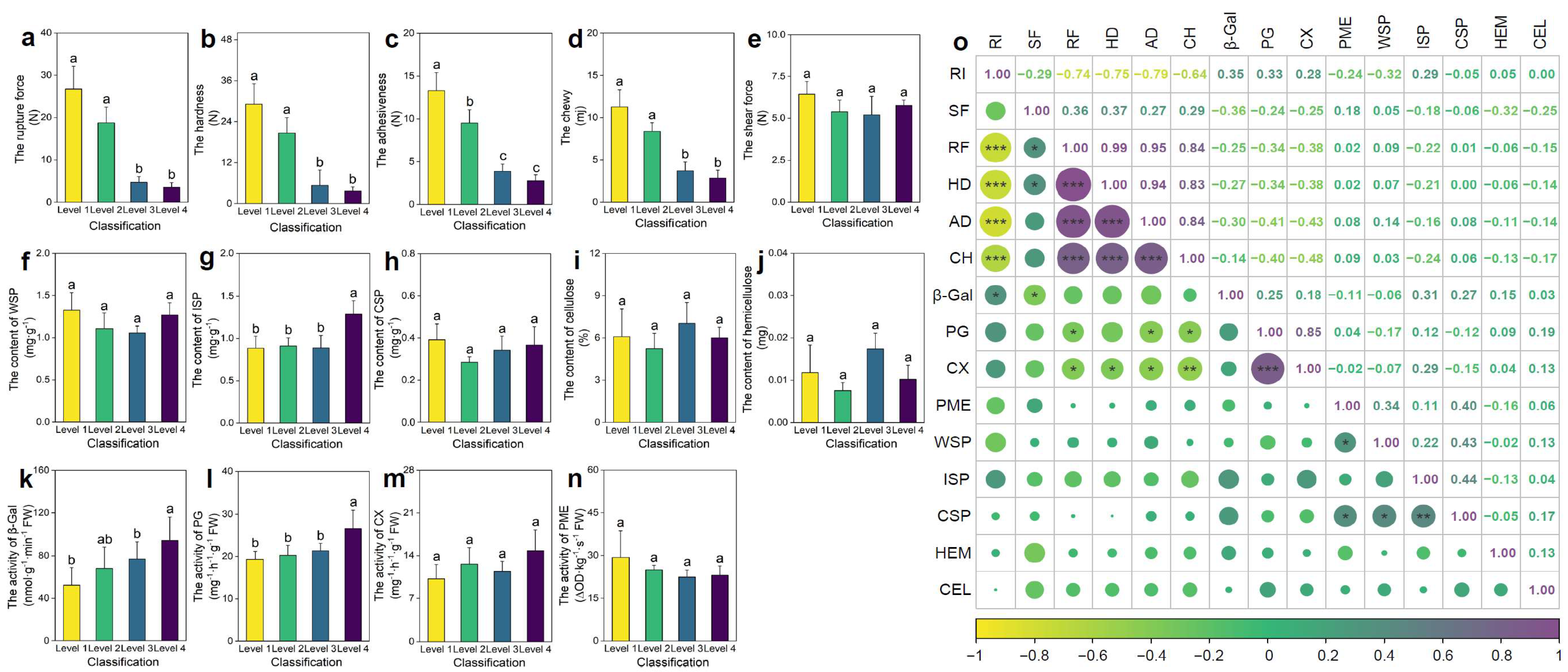
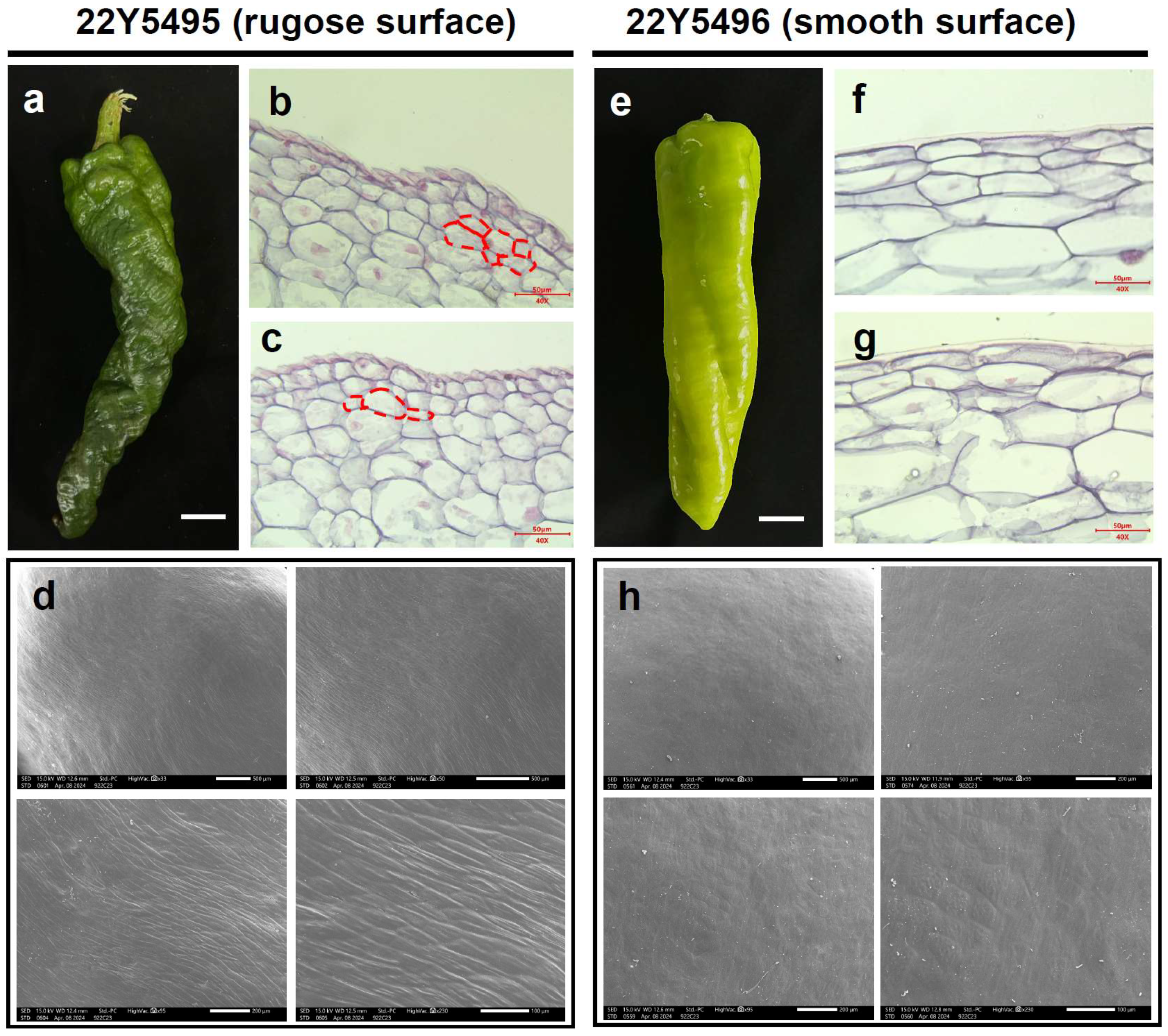
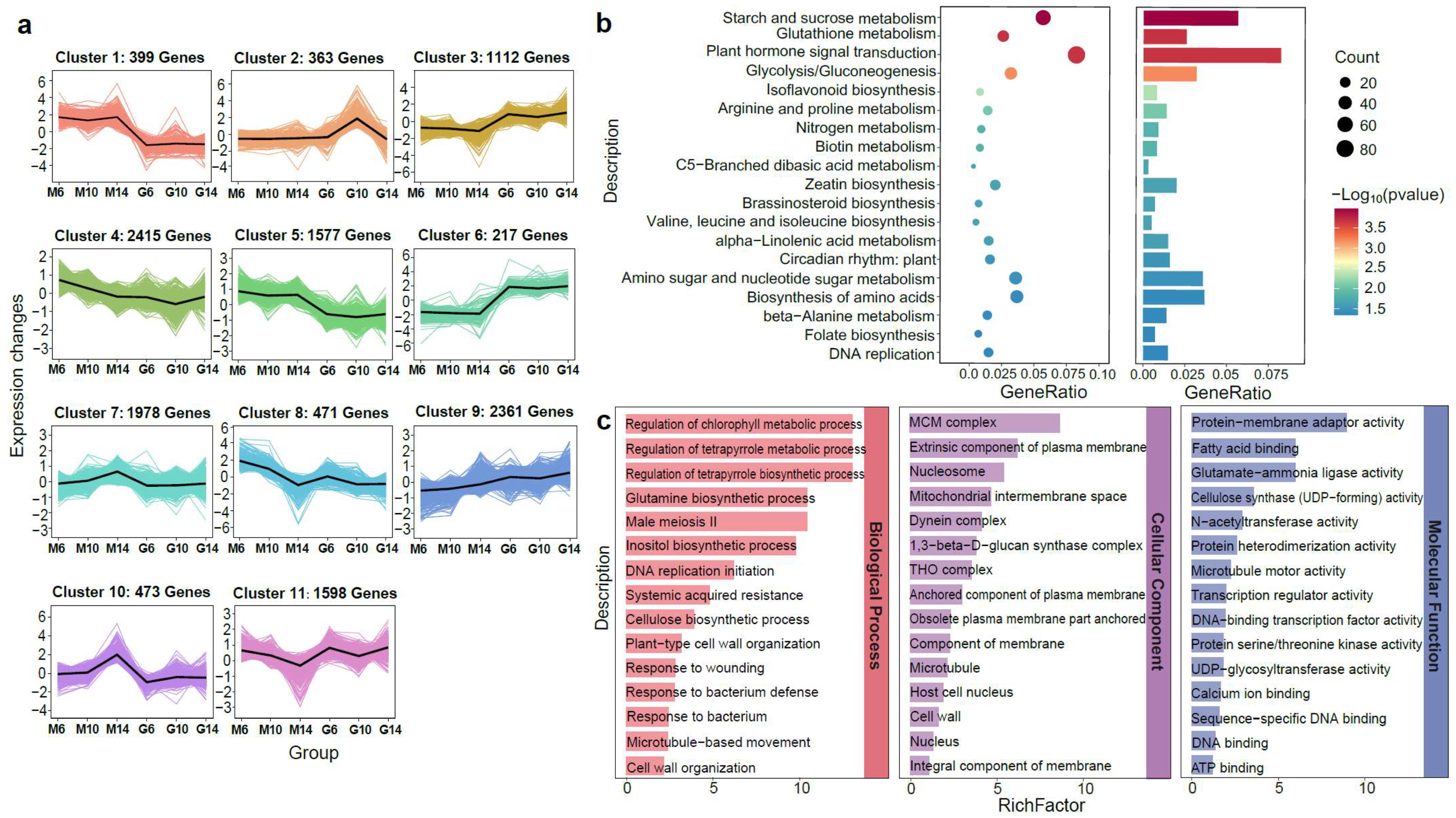
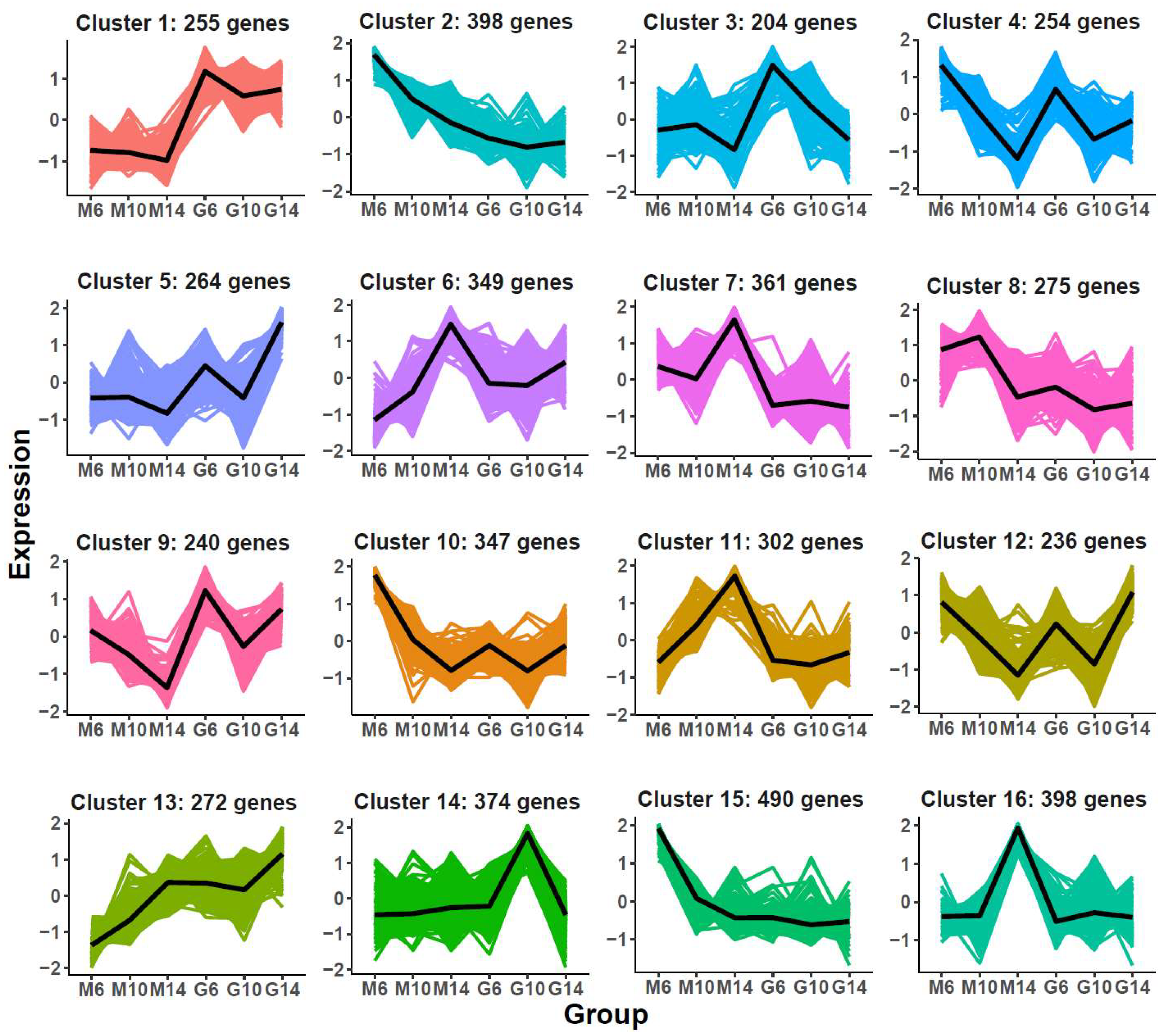

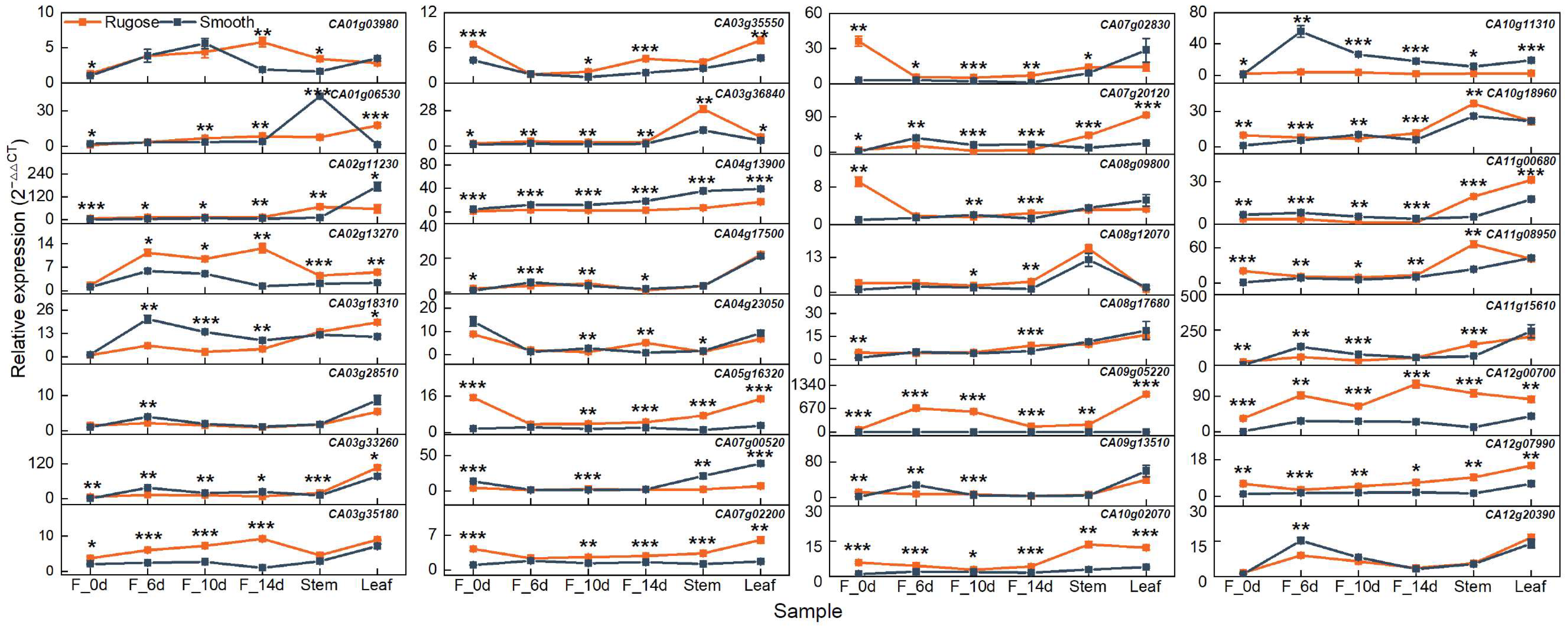
Disclaimer/Publisher’s Note: The statements, opinions and data contained in all publications are solely those of the individual author(s) and contributor(s) and not of MDPI and/or the editor(s). MDPI and/or the editor(s) disclaim responsibility for any injury to people or property resulting from any ideas, methods, instructions or products referred to in the content. |
© 2025 by the authors. Licensee MDPI, Basel, Switzerland. This article is an open access article distributed under the terms and conditions of the Creative Commons Attribution (CC BY) license (https://creativecommons.org/licenses/by/4.0/).
Share and Cite
Xie, Y.; Zhang, H.; Li, C.; Cheng, Q.; Sun, L.; Shen, H. Histological and Transcriptomic Insights into Rugose Surface Formation in Pepper (Capsicum annuum L.) Fruit. Plants 2025, 14, 2451. https://doi.org/10.3390/plants14152451
Xie Y, Zhang H, Li C, Cheng Q, Sun L, Shen H. Histological and Transcriptomic Insights into Rugose Surface Formation in Pepper (Capsicum annuum L.) Fruit. Plants. 2025; 14(15):2451. https://doi.org/10.3390/plants14152451
Chicago/Turabian StyleXie, Yiqi, Haizhou Zhang, Chengshuang Li, Qing Cheng, Liang Sun, and Huolin Shen. 2025. "Histological and Transcriptomic Insights into Rugose Surface Formation in Pepper (Capsicum annuum L.) Fruit" Plants 14, no. 15: 2451. https://doi.org/10.3390/plants14152451
APA StyleXie, Y., Zhang, H., Li, C., Cheng, Q., Sun, L., & Shen, H. (2025). Histological and Transcriptomic Insights into Rugose Surface Formation in Pepper (Capsicum annuum L.) Fruit. Plants, 14(15), 2451. https://doi.org/10.3390/plants14152451






